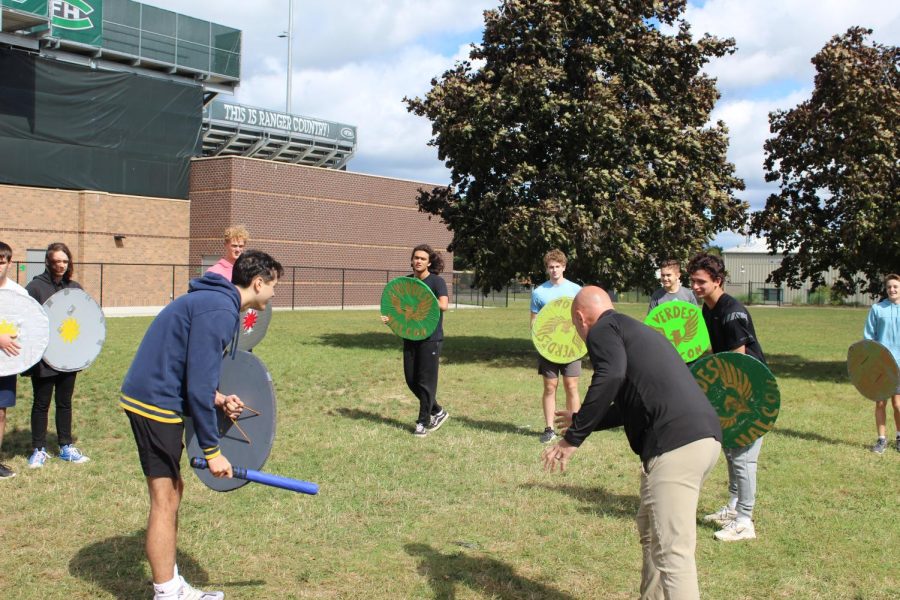Anderson enthusiastically refereeing a gladiator fight, which is one of the hands-on activities that he does.
FHC teachers create a positive learning environment through unique teaching styles
Eva Harshman, Copy Editor
It’s not a typical sight to see leaders of several countries meeting in a high school classroom, but that’s exactly what can be found in history teacher Brad Anderson’s classroom during a certain time of the school year.
Rather than constantly taking notes and filling their time with busy work, Anderson’s students use their classroom time to gain real-life experience through activities such as Age of Empires and the World Diplomacy Game.
“I want to make sure students are not only at school for the content but also to enjoy themselves,” Anderson said. “You can have an adventure and learn at the same time; you can enjoy the learning process through teamwork, through adventure, [and] through hands-on learning.”
No matter how much dedication goes into each of these projects and experiences, Anderson is aware that high school is just a brief snippet of one’s entire life, and very few of the many moments are remembered for years to come.
This may sound disheartening for some, but this makes Anderson all the more determined to make high school education worthwhile. The more exciting the activities, the more likely the student is to remember them.
“You only remember a few things,” Anderson said. “I want to help students create memories through those tactile, hands-on learning experiences. You’re going to remember it. You’re going to remember how you feel, you’re going to prepare differently, [and] you’re going to be more enthusiastic and engaged.”
Anderson isn’t the only teacher at FHC who teaches valuable lessons through untraditional methods. Science teacher Chad Scholten has introduced hands-on learning to multiple of the classes that he teaches.
Science certainly requires a different teaching style than history and social studies classes, but it is still very possible to teach in an engaging way. This can be done through models, labs, and other hands-on experiments. Scholten has implemented some of these concepts into his anatomy class where the students built a clay model, including the muscles and organs of a human.
“You can learn anatomy just by looking at textbook diagrams,” Scholten said. “But, when you can make it three-dimensional and you can see it in space, then you’re using more of the visualization of your senses. So, the students usually do better if I can have some type of performance-based or lab-practical—actually doing something—rather than a multiple-choice test.”
Scholten teaches by this policy whenever possible in his classroom. He even has a button—from the same company that creates the supplies for the models—that sums up his thoughts: “The mind cannot forget what the hands have learned.”
His work with hands-on science learning doesn’t stop there. Scholten also runs an independent study during his sixth hour that, while still on school grounds, is not within his classroom. Scholten’s students take what they learned in their environmental science classes out to the greenhouse.
“They learn about the concept in the class,” Scholten said. “Then, with the greenhouse, they’re planting the seeds, fertilizing the plants, [doing] some harvesting, and maintaining in terms of insects and pests. We have to deal with that.”
Although most teachers have the option to create lessons that involve hands-on learning, art teacher Grace Stynes must always teach in such a way. Even though this is challenging, it is the only way that art classes can be taught.
Thankfully, Stynes enjoys working in this way herself and can’t imagine teaching her students in a different manner. Because Stynes must work in this fashion and can do so with passion, it is clear that such learning isn’t impossible to implement in a classroom.
“When we move our bodies in this way of hands-on art, the brain activates in areas that you might not get if you’re just sitting, writing, and thinking of memorization,” Stynes said. “So, it’s really important to have your body moving in order to help your learning.”
Even though art is almost strictly hands-on, there is room for improvement and more creativity—Stynes acknowledges this and works her hardest to make learning the best it can be for all students. By flipping the conversation and allowing students to experiment on their own, Stynes allows students to understand concepts in a way that makes sense to them.
Such forms of teaching should be a model to classrooms around the world. FHC, so far, has shown many examples of how students can learn in methods that are above conventional, but just as anywhere else, more can be done.
“There are a lot of great examples of this happening at FHC,” Stynes said. “But, I’m of the manner that there can always be more; as teachers, that’s the mentality that most people have. We’re learning too, and so I’m always trying to make things more hands-on.”
The Central Trend • Copyright 2025 • FLEX WordPress Theme by SNO • Log in
